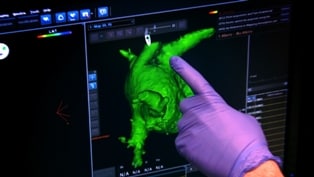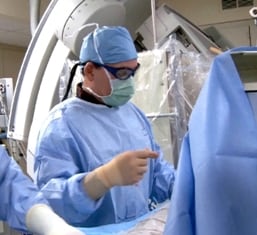LARIAT Cardiac Procedure Reduces Risk of Stroke
Watch Video
First Case in Oregon Performed at Asante Rogue Regional Medical Center

Dr. Pena indicates left atrial appendage during a LARIAT procedure.
Dr. Eric Pena, Southern Oregon Cardiology, performed the first LARIAT procedure in Oregon at Asante Rogue Regional Medical Center on February 27, 2013. With this groundbreaking technique, Dr. Pena uses two catheters—one with a tiny lariat—to tie off the left atrial appendage (a finger-shaped pocket) of the heart , which is known to be a major source of blood clots that can lead to strokes in patients with atrial fibrillation (AFib). Before the LARIAT procedure, tying off atrial appendages required open heart surgery.

Eric Pena, MD, Electrophysiology.
This new procedure is a potential lifesaver and has proven to be very effective in lowering the risk of blood clots and stroke in patients with AFib,” said Dr. Pena. “We have come a long ways with anti-coagulation drugs, but the risk of stroke still increases by 1 percent a year, that’s 10 percent in a decade.” Some patients are unable to take blood thinning medications, Pena added.
The game-changing, FDA-approved (Medicare approval still pending) technique is performed in a cardiac catheterization lab using two catheters. One is guided by the physician from a vein in the groin to the left atrial appendage inside the heart. The other catheter has the LARIAT suture. Dr. Pena guides it to the left atrial appendage from outside the heart by accessing between the heart and the heart sack (pericardium) underneath the rib cage. The two catheters have magnets on the tip so they may connect.
“This allows us to stabilize the appendage from both the inside and the outside of the heart while we deploy the suture around the appendage and exclude it from the central circulation,” Dr. Pena explained. This permanently seals off the appendage from the rest of the heart, greatly reducing the risk for stroke.

Eric Pena, MD, electrocardiolgy, performs a LARIAT procedure at Asante Rogue Regional Medical Center
Left atrial appendages are problem areas as blood tends to collect in them, providing an environment for blood clotting which leads to stroke. Atrial fibrillation affects an estimated three million people, and patients with this condition are five times more likely to have a stroke, research shows. The LARIAT procedure removes the main source of atrial fibrillation-related stroke while avoiding the potentially serious side effects associated with blood-thinning medications as well as the need for open heart surgery.
This procedure is not yet covered by Medicare, but is covered by many insurance plans. Individuals should check with their doctor and their health plan for more information.
Why Atrial Fibrillation and Atrial Appendages Increase Stroke Risk
Atrial fibrillation causes the heart to beat irregularly, either too fast or too slow. This makes it harder for the heart’s upper and lower chambers to stay in sync, leading to blood pooling in the left atrial appendage where dangerous clots will form. The left atrial appendage is a finger-shaped pocket that is attached to the left upper chamber. Studies show about 95 percent of strokes that occur due to blood clots in atrial fibrillation patients are from clots formed in the left atrial appendage.


